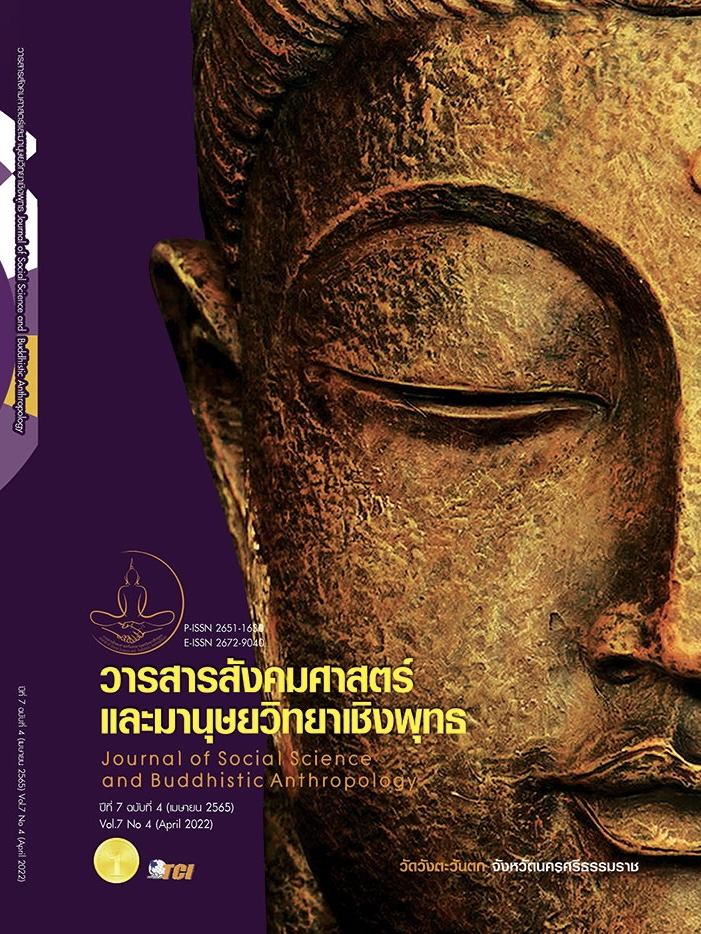GUIDELINE OF THE INTEGRATIVE PARTICIPATORY ADMINISTRATION MODEL THROUGH PHYSICAL EDUCATION DECREASING VIOLENT BEHAVIOR OF STUDENTS UNDER PATHUMWAN INSTITUTE OF TECHNOLOGY
Keywords:
Model Development, Management, Participation, Violent BehaviorAbstract
The objective of this research article was to study the development of an integrated management model in participatory physical education to reduce violent behavior among students of Pathumwan Institute of Technology. It is a cross-sectional research method. Data were collected using a semi-structured interview form. Interviews with 16 experts and 12 stakeholders were selected by specific selection. And use the necessary needs questionnaires Inquire about regular semester students Of the Pathumwan Institute of Technology for the academic year 2020, which consented to the data, 326 people out of a total of 393 people were analyzed by the content analysis method. Inductive conclusion and an analysis of the Applied Needs Index. The results of the research revealed that the need for the development of an integrated management model in participatory physical education to reduce violent behavior among students of Pathumwan Institute of Technology has a total of 13 aspects. It was found that The first 3 were the behavioral and institutional roles that should have on student behavior in non-violence with PNImodified value of 0.469, the second was the role of institutional administrators with PNImodified value of 0.466, respectively. 3 is the organization of physical education activities with a PNImodified value of 0.465, with a guideline for the development of an integrated management model in physical education with participation to reduce violent behavior of students of Pathumwan Institute of Technology, divided into 4 parts: Part 1 Structure and the role of the institution in 5 areas, part 2, the role of network partners, 3 aspects, part 3, the organization of physical education learning activities, 3 aspects, and 4, the monitoring and support system has 2 aspects.
References
กรมวิชาการ. (2545). หลักสูตรการศึกษาขั้นพื้นฐาน พุทธศักราช 2545. กรุงเทพมหานคร: องค์การรับส่งสินค้าและพัสดุภัณฑ์ (ร.ส.พ.).
กระทรวงศึกษาธิการ. (2553). หลักสูตรแกนกลางการศึกษาขั้นพื้นฐานพุทธศักราช 2551 (พิมพ์ครั้งที่ 3). กรุงเทพมหานคร: ชุมนุมสหกรณ์การเกษตรแห่งประเทศไทยจำกัด.
เกศริน วงษ์มั่น. (2553). ผลการใช้โปรแกรมการกำกับตนเองที่มีต่อการมีวินัยในการเรียนของนักเรียนช่วงชั้นที่ 3 โรงเรียนศรีนภเขตวิทยา (พระปริยัติธรรม แผนกสามัญศึกษา) สังกัดสำนักงานพระพุทธศาสนาแห่งชาติ จังหวัดนครสวรรค์. ใน วิทยานิพนธ์การศึกษามหาบัณฑิต สาขาวิชาจิตวิทยาการแนะแนว. มหาวิทยาลัยศรีนครินทรวิโรฒ.
เกียรติวัฒน์ วัชญากาญจน์ และคณะ. (2556). การพัฒนารูปแบบการเรียนการสอนพลศึกษาสำหรับนักศึกษาวิชาชีพครู สาขาวิชาพลศึกษา สถาบันการพลศึกษา. วารสารบัณฑิตศึกษา มหาวิทยาลัยราชภัฏวไลยอลงกรณ์ ในพระบรมราชูปถัมภ์, 7(3), 1-18.
ชลัท ประเทืองรัตนา. (2556). แนวทางในการอยู่ร่วมกันอย่างสันติระหว่างนักศึกษาสถาบันเทคโนโลยีปทุมวันกับมหาวิทยาลัยเทคโนโลยีราชมงคลตะวันออกวิทยาเขตอุเทนถวาย. วารสารพัฒนบริหารศาสตร์ สถาบันบัณฑิตพัฒนบริหารศาสตร์, 53(3), 151-173.
ชิษณุชา นวลปาน และศรัณย์ ธิติลักษณ์. (2563). ปัญหาความรุนแรง: กระบวนการครอบงำความคิดของนักศึกษาอาชีวะในเขตกรุงเทพมหานคร. วารสารรังสิตบัณฑิตศึกษาในกลุ่มธุรกิจและสังคมศาสตร์, 6(1), 28-41.
ประกิต หงส์แสนยาธรรม. (2552). การพัฒนารูปแบบการบริหารจัดการสมาคมกีฬาจังหวัด. ใน ดุษฎีนิพนธ์ปรัชญาดุษฎีบัณฑิต สาขาวิชาวิทยาศาสตร์การออกกำลังกายและการกีฬา. มหาวิทยาลัยบรูพา.
มัลลิกา ต้นสอน. (2543). กลยุทธ์ธุรกิจ. กรุงเทพมหานคร: บริษัทเอ็กซเปอร์เน็ท.
วารุณี วรศักดิ์เสนีย์. (2554). การพัฒนารูปแบบการจัดกิจกรรมพลศึกษาตามแนวคิดการปรับพฤติกรรมทางปัญญาเพื่อลดพฤติกรรมก้าวร้าวของนักเรียนมัธยมศึกษาตอนต้น. ใน ดุษฎีนิพนธ์ครุศาสตรดุษฎีบัณฑิต สาขาวิชาพลศึกษา. จุฬาลงกรณ์มหาวิทยาลัย.
สำนักงานปลัดกระทรวงศึกษาธิการ. (2559). แผนพัฒนาการศึกษาของกระทรวงศึกษาธิการฉบับที่ 12 พ.ศ. 2560 - 2564. กรุงเทพมหานคร: สำนักงานปลัดกระทรวงศึกษาธิการ.
สุวิมล ว่องวาณิช. (2558). การวิจัยประเมินความต้องการจาเป็น (พิมพ์ครั้งที่ 3). กรุงเทพมหานคร: สำนักพิมพ์แห่งจุฬาลงกรณ์มหาวิทยาลัย.
Bryson, J. M. (2004). Strategic Planning for Public and Nonprofit Organizations: A Guide to Strengthening and Sustaining Organizational Achievement (3rd ed). San Francisco, Calif: Jossey-Bass.
Kemmis K. & McTaggart R. (2000). Participatory action research Handbook of qualitative research. London: SAGE.
Robbins, S. P. (2007). Organization Theory: Structure, Design, and Applications. New Jersey: Prentice-Hall.
Downloads
Published
How to Cite
Issue
Section
License
Copyright (c) 2022 Journal of Social Science and Buddhistic Anthropology

This work is licensed under a Creative Commons Attribution-NonCommercial-NoDerivatives 4.0 International License.








